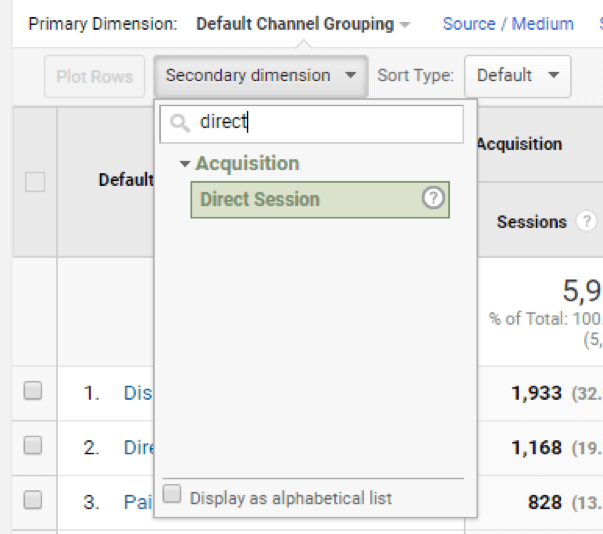How to Utilize Secondary Dimension in Google Analytics for Deeper Insights
Enhance Your Information Analysis Utilizing Second Measurement in Google Analytics
Checking out the capacities of second measurements in Google Analytics opens up a world of opportunities for refining information analysis. By layering extra dimensions onto main data collections, a more intricate narrative emerges, losing light on user interactions and performance indicators.
Recognizing Second Dimensions
Second measurements in Google Analytics refer to additional parameters that can be added to the main measurement, allowing for a much more thorough analysis of information (Secondary Dimension in Google Analytics). By including second dimensions, analysts can segment and filter data to uncover patterns, fads, and correlations that may not be apparent when looking at the information as a whole.

Advantages of Using Additional Measurements
When assessing information in Google Analytics, the use of additional dimensions offers important understandings into customer habits and performance metrics. By adding a second dimension to your key information, you can delve much deeper right into the qualities of your site visitors and their communications.
Additionally, second measurements boost the context of your key information, providing a much more thorough view of customer interaction and performance metrics. Overall, the use of second dimensions in Google Analytics can considerably enhance the depth and top quality of your data analysis, leading to more informed decision-making and boosted outcomes.
How to Include Second Dimensions
By incorporating second measurements in Google Analytics, users can obtain much deeper insights into their information analysis procedure, enabling for more comprehensive assessment of customer habits and performance metrics. Including additional dimensions is an uncomplicated process that can considerably boost the depth of evaluation. When in the report, locate the "Additional measurement" tab above the data table.
Analyzing Data With Secondary Dimensions
Utilizing secondary dimensions in data analysis supplies a much more comprehensive understanding of customer habits and performance metrics. By adding a secondary measurement to your key information embeded Bonuses in Google Analytics, you can delve deeper right into the qualities of your site visitors and their interactions. For example, integrating the main dimension of 'source/medium' with the secondary dimension of 'landing web page' can disclose which particular pages are drawing in traffic from various sources, aiding you enhance these web pages for better engagement.

Basically, examining information with additional dimensions encourages you to gain valuable insights into user behavior, determine fads, and make informed decisions to improve the efficiency of your digital homes.
Best Practices for Second Dimensions
In data analysis, incorporating secondary measurements properly can considerably boost the depth of understandings originated from metrics and helpful hints customer behavior patterns. When using secondary dimensions in Google Analytics or any kind of other analytical device, it is vital to stick to ideal practices to ensure the precision and relevance of the information analysis.
One trick ideal method is to very carefully select additional measurements that complement the key dimension being examined. Choosing secondary measurements that offer additional context or more division can provide a more comprehensive understanding of the data. It is also crucial to stay clear of overcomplicating the analysis by consisting of a lot of secondary measurements, which may result in complication or dilution of insights.
Additionally, it is a good idea to try out various combinations of key and secondary dimensions to reveal new relationships and patterns. On a regular basis improving the choice and examining of additional dimensions based on the details objectives of the analysis can result in more workable understandings. By adhering to these ideal techniques, information experts can leverage secondary measurements efficiently to enhance the total information evaluation procedure and decision-making capacities.

Final Thought
In conclusion, integrating secondary measurements in Google Analytics is crucial for a detailed information analysis method. By leveraging secondary measurements along with primary ones, online marketers and experts can discover valuable understandings and connections that can educate decision-making and maximize read digital advertising and marketing strategies. Understanding how to successfully make use of second measurements and following best techniques will certainly permit experts to remove meaningful information and enhance their overall performance metrics.
Secondary dimensions in Google Analytics refer to extra criteria that can be added to the key dimension, enabling for an extra in-depth evaluation of data. By incorporating secondary measurements, experts can sector and filter information to uncover patterns, fads, and connections that might not be evident when looking at the data as a whole. Integrating the primary measurement of 'source/medium' with the secondary measurement of 'landing web page' can expose which certain pages are attracting website traffic from different sources, aiding you enhance these pages for better involvement.
One trick finest technique is to carefully select additional dimensions that enhance the key measurement being analyzed. By following these best practices, information experts can take advantage of secondary dimensions successfully to enhance the total information evaluation procedure and decision-making abilities.